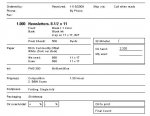Hello Community,
i am curious: Has anyone a link between the MIS and the press? I am wondering if job-related data (quantity, sheet sizes, estimated make-ready times etc) will be passed through to your presses automaticly and if the press reports data back into the MIS (either via fileinterface, JMF or any other technology).
I am aware that a lot of print shops using external terminals with manual data collection for reporting back - but i want to know if the data comes back without the use of external terminals. Straight from the press back into the MIS.
Anyone else who is reading this and is not involved (yet?): Where do you see the pros and the cons on that?
Cheers,
SlRlUS
i am curious: Has anyone a link between the MIS and the press? I am wondering if job-related data (quantity, sheet sizes, estimated make-ready times etc) will be passed through to your presses automaticly and if the press reports data back into the MIS (either via fileinterface, JMF or any other technology).
I am aware that a lot of print shops using external terminals with manual data collection for reporting back - but i want to know if the data comes back without the use of external terminals. Straight from the press back into the MIS.
Anyone else who is reading this and is not involved (yet?): Where do you see the pros and the cons on that?
Cheers,
SlRlUS











